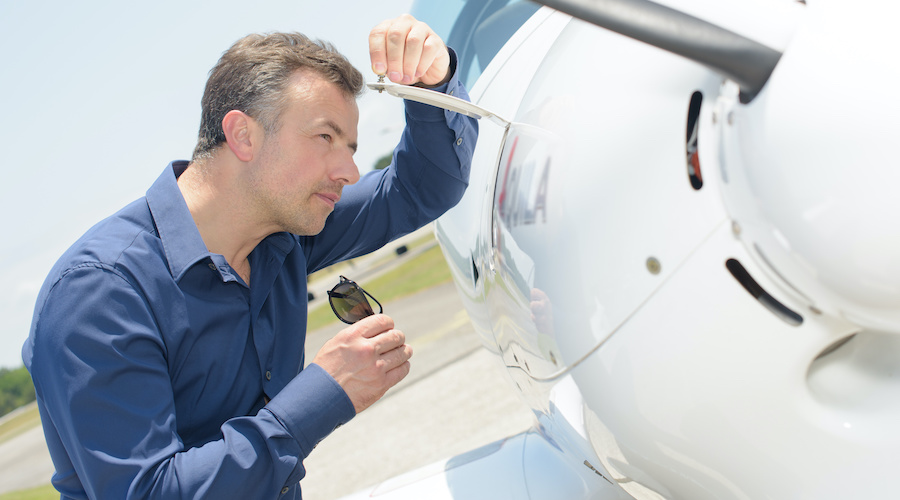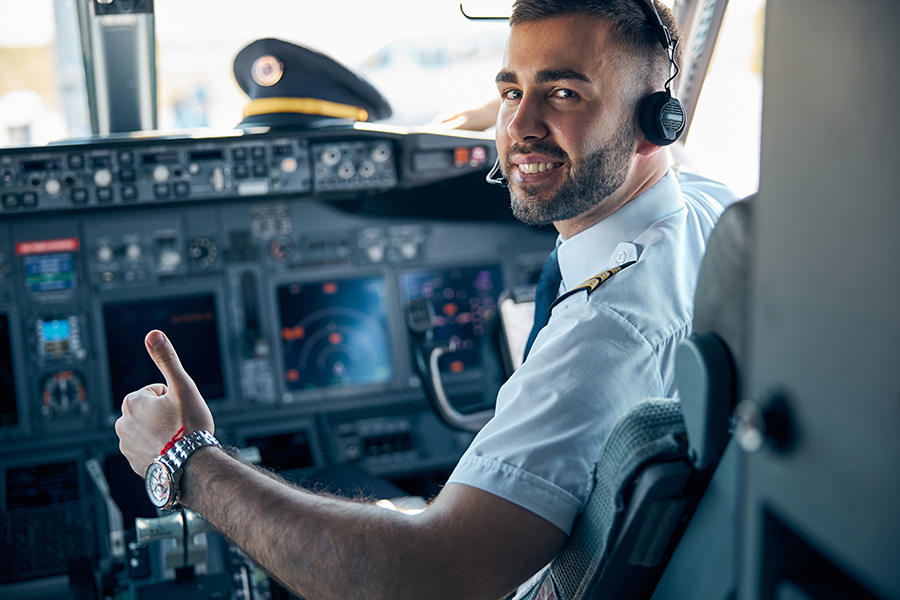Takeoff in any aircraft occurs when the airplane leaves the ground and becomes airborne. However, there is a lot more to it than that. There are a number of things which need to be done in advance, and the takeoff itself is split into a few different stages.
This is true of any aircraft, from a small single-engined training airplane to a large passenger carrying airliner. Obviously some of the procedures will be slightly different in aircraft of different sizes and types. In this article, we will take a detailed look at the procedures for a small aircraft, such as is flown by the majority of private pilots.
Things which must be done by the pilot before takeoff
When you go out for a drive, you may well jump in your car and just go. Perhaps you briefly check that you have enough fuel, and maybe you take a cursory look at the tires. But that is probably all that you do.
However, there is much more to do before you depart in an airplane. Firstly, there will be a certain amount of paperwork to do. If the pilot is leaving from an airport, he or she will need to sign out, and may need to file a flight plan. If he has passengers, he will need to give them a safety briefing, which will probably be fairly short, but is actually a legal requirement.
After this the pilot will need to do his pre-flight checks. The external checks mean that he walks around the aircraft, following a checklist and taking careful note of the state of the whole machine, from wings to other moving surfaces to fuel state. This is very important. After all, if anything is wrong, he cannot just stop in the air and get it sorted, in the same way as you stop in a car by the side of the road. So he needs to make sure of everything in advance.
After that the pilot climbs aboard, helps the passengers do so, and ensures everyone is safely strapped in and that there are no loose articles around. Then there are a large number of internal checks to be completed, some before switching on the engine, some done with the engine running, and some at full power. Again, the pilot needs to ensure that everything is working as it should before departure.
The pilot will then call on the radio, saying he is ‘ready to taxi’.
Preparing for takeoff
Taxi-ing the aircraft involves moving it along the ground from where it has been parked, up to the start of the runway. During taxi-ing, there are other checks which need to be done, mainly to ensure that the steering on the ground works as it should do.
Small aircraft are steered by use of the rudders, with the pilot using his feet on the pedals. The pilot does not use the yoke or stick for this purpose – although it is not unusual to see new trainee pilots attempting to do so! Some aircraft are difficult to steer on the ground, particularly those with a tailwheel. However, there are not that many tailwheel aircraft being flown any more, and most modern aircraft are fairly easy to taxi. Nevertheless, taxi-ing must be done slowly and with care. The wings of an aircraft stick out further than the pilot often expects them to, and accidents during taxi-ing are not that uncommon.
When the pilot reaches the start of the runway, or the line of aircraft waiting to take off, he will have a few final checks to do. He will then call on the radio that he is ‘ready for departure’. He never, ever says he is ready for takeoff. This point is so important that we will have a look at how it came about…
A word about radio calls before takeoff
When the pilot calls ‘ready for departure’, there are several possible answers he could get from Air Traffic Control. He may be asked to hold his position, especially if other aircraft are waiting to take off. He may be asked to ‘line up and wait’, which means he can taxi to the start of the runway, and position the aircraft ready to move down the runway, or commence the ‘takeoff roll’, as it is called.
He must not actually commence the takeoff roll until ATC tells him ‘cleared for takeoff’. This is the only phrase ever used which includes the word ‘cleared’. Until that point, the word ‘departure’ is always used. The reason for this is very important, and back to a serious aviation accident which took place at Tenerife, in the Canary Islands, in 1977….
Tenerife airport disaster
On 27th March 1977, two Boeing 747 jets collided on the runway at Tenerife North Airport, resulting in 583 fatalities. This accident is still considered to be the deadliest in aviation history.
The airport was crowded at the time due to an earlier terrorist incident at Gran Canaria Airport, and therefore airliners were using the runway for taxi-ing. There were also patches of thick fog on the runway. The accident occurred when one plane initiated its takeoff run before the other plane had taxied clear of the runway. The two aircraft could not see each other due to the fog, and the impact and resulting fire killed almost everyone in both aircraft.
The subsequent investigation found that the primary cause of the accident was that the captain of the departing aircraft mistakenly believed that he had been cleared for takeoff when he heard the word ‘takeoff’ being used in a radio call.
The disaster had a lasting influence on the industry, highlighting in particular the vital importance of using standardized phraseology in radio communications. Since then, the word ‘takeoff’ is only used when the plane is actually ‘cleared for takeoff’. Otherwise the word ‘departure’ is used.
The takeoff roll
The takeoff roll or ground roll is the portion of the takeoff procedure during which the airplane is accelerated from a standstill to an airspeed that provides sufficient lift for it to become airborne.
After he has lined up the aircraft with the runway in use, the pilot generally accelerates to full power. The aircraft will try to leave the ground as its speed increases, but the pilot holds it on the ground until it reaches the optimum speed for takeoff. He must not allow it to leave the ground at a slower speed, or there is a danger of a stall.
As it goes faster, there is more air flowing over the aircraft wings. According to a principle of aerodynamics called Bernoulli’s Principle, fast-moving air is at lower pressure than slow-moving air, so the pressure above the wing is lower than the pressure below. This creates the lift that powers the plane upward, and is how the takeoff is actually able to take place.
Lift-off is when the wings are lifting the weight of the airplane off the surface. At this point, the pilot must ensure that the plane climbs at the correct angle and airspeed. If the plane goes too slowly there is a danger of a stall, but if it goes too fast it will not climb quickly enough for safety. It is essential to climb to a safe height as quickly as possible, since in the unlikely event of engine failure it would be very difficult for the aircraft to land safely if it was too near the ground. Engine failure after takeoff is an emergency which is practiced by trainee pilots quite frequently, but it is a difficult procedure, and one which every pilot hopes he will never have to perform in earnest!
Aborting the takeoff
If anything seems wrong during the takeoff roll, the pilot will abort the takeoff, which means he will apply the brakes and come to a halt on the ground before the end of the runway. Aborted takeoffs happen to all aircraft, large and small, though quite rarely.
There are a number of reasons for an aborted takeoff, from engine problems to a nebulous feeling that something is just not quite right. It is better to err on the side of caution than to risk a problem immediately after takeoff. Usually after an aborted takeoff the pilot will return to the airport for safety checks before trying again.
Acts immediately after takeoff
There are a few checks which need to be performed immediately after takeoff. After that the flaps are lifted, if they have been used for takeoff, and the wheels retracted in an aircraft which has retractable wheels. Both of these introduce drag, something which is not wanted when flying.
The pilot can then set his first heading, climb to the height required, and set the power for the cruise. His flight has begun!
Some unconventional takeoffs
Sometimes the takeoff procedure is done in a slightly different way. This may be because the runway is very short, usually at a rather small airfield, or because the ground is soft if the airfield has grass runways.
As short field takeoff begins with a calculation as to whether takeoff is even possible for that particular type of airplane in the current conditions. If not, it should not even be attempted.
There are different techniques for short field takeoffs, but usually a small amount of flap is used, and the aircraft is lined up as far back towards the end of the runway as possible, so that the maximum space is available. Then the aircraft is increased to full power before the takeoff roll is commenced, by the pilot holding it on the brakes. This means it can accelerate to the climb speed in as short a space as possible.
Once the aircraft reaches the best speed for lift-off, it allowed to leave the ground and climb at the best angle to enable it to clear any obstacles on the ground. The angle of climb can then be reduced, so that the aircraft is climbing at the best rate of climb, as is done after a normal takeoff.
For a soft field takeoff, the pilot should try not to come to a halt on the runway, but to commence the takeoff roll immediately after taxi-ing. This is to try to ensure that the airplane does not stick in mud, ice, or whatever is causing the field to be soft.
After this the pilot takes off as normal, but at as slow a speed as possible, holding the aircraft in ground effect until it reaches a safe flying speed. The aim is to spend as little time on the soft ground as possible, while ensuring the takeoff is safe.
Conclusion
As should be clear by now, the takeoff is an important part of flying. It is usually not difficult, but there are many things which can go wrong. So the takeoff should be treated with care and caution to ensure a safe flight.



